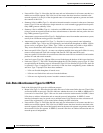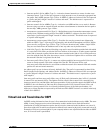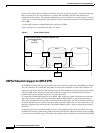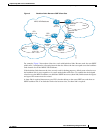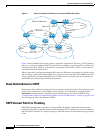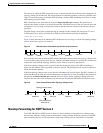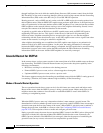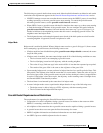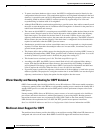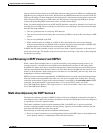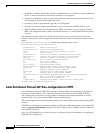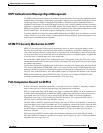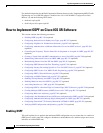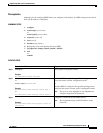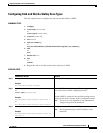
Implementing OSPF on Cisco IOS XR Software
Information About Implementing OSPF on Cisco IOS XR Software
RC-190
Cisco IOS XR Routing Configuration Guide
OL-14356-01
• To ensure consistent databases after a restart, the OSPFv3 configuration must be identical to the
configuration before the restart. (This requirement applies to self-originated information in the local
database.) A graceful restart can fail if configurations change during the operation. In this case, data
forwarding would be affected. OSPFv3 resumes operation by regenerating all its LSAs and
resynchronizing its database with all its neighbors.
• Although IPv6 FIB tables remain unchanged during a graceful restart, these tables eventually mark
the routes as stale through the use of a holddown timer. Enough time is allowed for the protocols to
rebuild state information and converge.
• The router on which OSPFv3 is restarting must send OSPFv3 hellos within the dead interval of the
process restart. Protocols must be able to retain adjacencies with neighbors before the adjacency
dead timer expires. The default for the dead timer is 40 seconds. If hellos do not arrive on the
adjacency before the dead timer expires, the router takes down the adjacency. The OSPFv3 Graceful
Restart feature does not function properly if the dead timer is configured to be less than the time
required to send hellos after the OSPFv3 process restarts.
• Simultaneous graceful restart sessions on multiple routers are not supported on a single network
segment. If a router determines that multiple routers are in restart mode, it terminates any local
graceful restart operation.
• This feature utilizes the available support for changing the purge time of existing OSPFv3 routes in
the Routing Information Base (RIB). When graceful restart is enabled, the purge timer is set to 90
seconds by default. If graceful restart is disabled, the purge timer setting is 0.
• This feature has an associated grace LSA. This link-scope LSA is type 11.
• According to the RFC, the OSPFv3 process should flush all old, self-originated LSAs during a
restart. With the Graceful Restart feature, however, the router delays this flushing of unknown
self-originated LSAs during a graceful restart. OSPFv3 can learn new information and build new
LSAs to replace the old LSAs. When the delay is over, all old LSAs are flushed.
• If graceful restart is enabled, the adjacency creation time of all the neighbors is saved in the system
database (SysDB). The purpose for saving the creation time is so that OSPFv3 can use the original
adjacency creation time to display the uptime for that neighbor after the restart.
Warm Standby and Nonstop Routing for OSPF Version 2
OSPFv2 warm standby provides high availability across RP switchovers. With warm standby extensions,
each process running on the active RP has a corresponding standby process started on the standby RP. A
standby OSPF process can send and receive OSPF packets with no performance impact to the active
OSPF process.
Nonstop routing (NSR) allows an RP failover, process restart, or in-service upgrade to be invisible to
peer routers and ensures that there is minimal performance or processing impact. Routing protocol
interactions between routers are not impacted by NSR. NSR is built on the warm standby extensions.
NSR alleviates the requirement for Cisco NSF and IETF graceful restart protocol extensions.
See Cisco IOS XR IP Addresses and Services Configuration Guide for more information on NSR.
Multicast-Intact Support for OSPF
The multicast-intact feature provides the ability to run multicast routing (PIM) when IGP shortcuts are
configured and active on the router. Both OSPFv2 and IS-IS support the multicast-intact feature.



